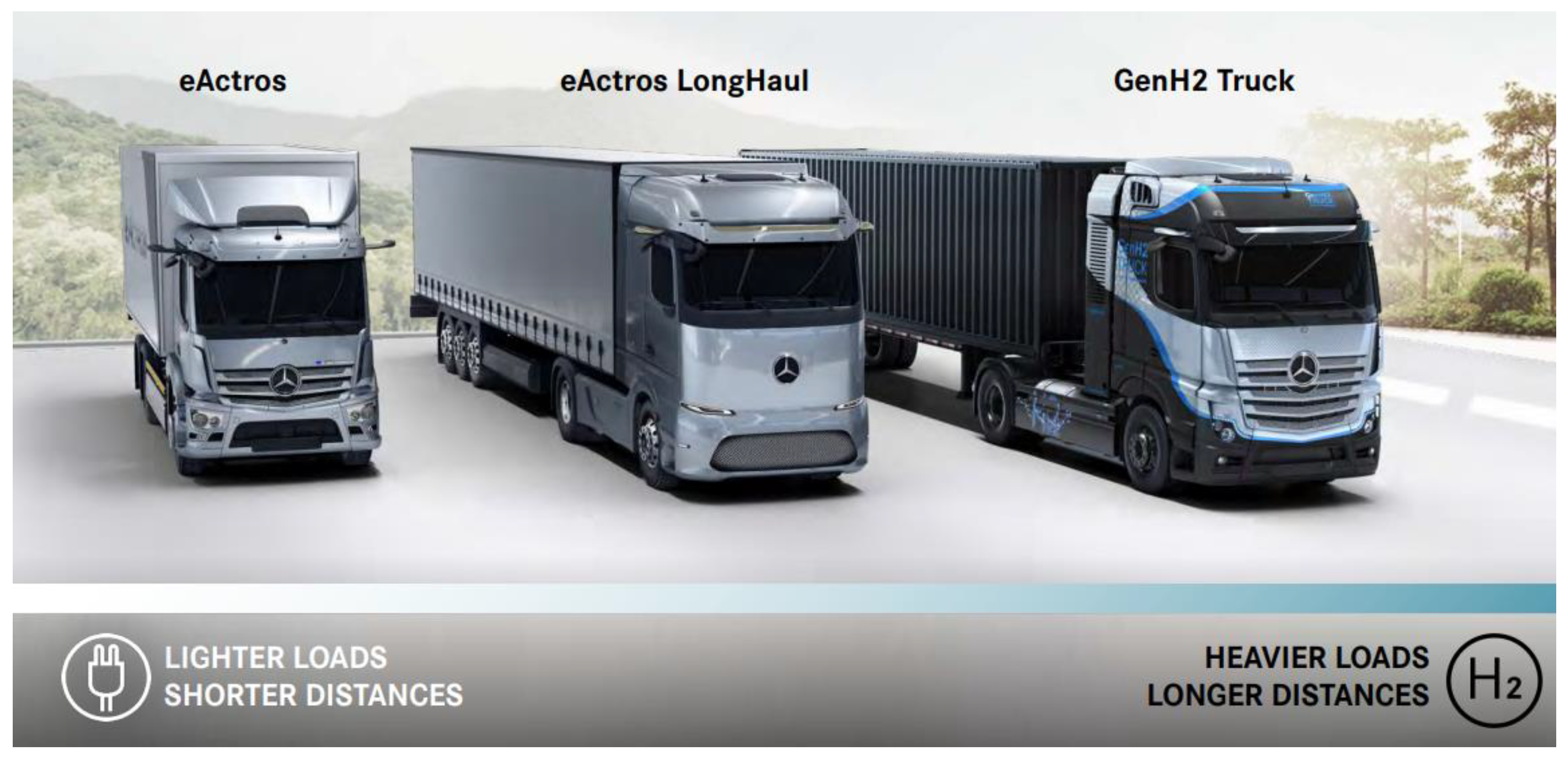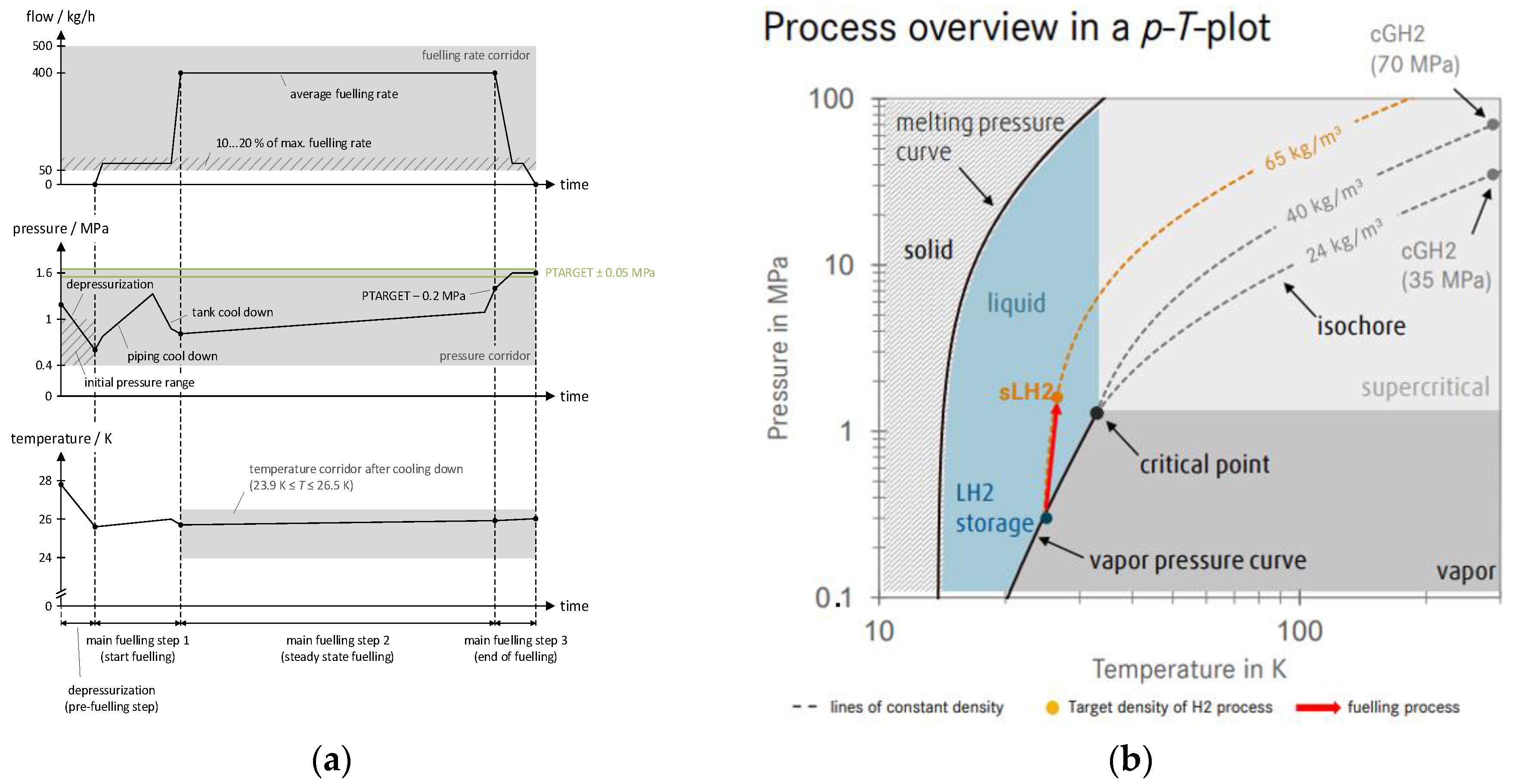Subcooled Liquid Hydrogen Technology for Heavy-Duty Trucks
Abstract
:1. Introduction
- (1)
- Compressed hydrogen gas (CHG) at room temperature and high pressures;
- (2)
- Cryo-compressed hydrogen (CcH2) at low temperatures and high pressures;
- (3)
- Liquid hydrogen (LH2) at very low temperatures (<20 K) and low pressures (<10 bar).

2. Vehicle Advantages
3. Refueling Protocol and HRS Advantages
4. Standardization
- Pre-fueling (incl. purging and leakage testing, pressure system determination, etc.);
- Main fueling (with two fueling steps, one with a reduced flow rate for the cooldown of piping and storage system and a second with a target fueling rate of 400 kg/h);
- Post-fueling (after the ptarget is reached, further purging and leakage testing needs to be conducted before the nozzle is disconnected).
5. Conclusions
Author Contributions
Funding
Data Availability Statement
Conflicts of Interest
References
- DeStatis, Road Transport Emission. Available online: https://www.destatis.de/Europa/EN/Topic/Environment-energy/CarbonDioxideRoadTransport.html#:~:text=Passenger%20cars%20and%20motorcycles%20accounted,trucks%20for%20a%20further%2013%25 (accessed on 23 October 2023).
- Ledna, C.; Muratori, M.; Yip, A.; Jadun, P.; Hoehne, C. Decarbonizing Medium- & Heavy-Duty On-Road Vehicles: Zero-Emission Vehicles Cost Analysis, NREL, 2022. Available online: https://www.nrel.gov/docs/fy22osti/82081.pdf (accessed on 24 October 2023).
- Hydrogen Council. Roadmap towards Zero Emissions: BEVs and FCEVs, 2021. Available online: https://hydrogencouncil.com/wp-content/uploads/2021/10/Transport-Study-Full-Report-Hydrogen-Council-1.pdf (accessed on 24 October 2023).
- Daimler Truck #HydrogenRecordRun: Mercedes-Benz GenH2 Truck Cracks 1000 Kilometer Mark with One Fill of Liquid Hydrogen. Available online: https://media.daimlertruck.com/go/HydrogenRecordRun (accessed on 13 November 2023).
- Rivard, E.; Trudeau, M.; Zaghib, K. Hydrogen Storage for Mobility: A Review. Materials 2019, 12, 1973. [Google Scholar] [CrossRef] [PubMed]
- H2Mobility, Overview Hydrogen Refuelling for Heavy Duty Vehicles, 2021. Available online: https://h2-mobility.de/wp-content/uploads/sites/2/2021/08/H2-MOBILITY_Overview-Hydrogen-Refuelling-For-Heavy-Duty-Vehicles_2021-08-10.pdf (accessed on 23 October 2023).
- DOE Hydrogen and Fuel Cell Technology Office. Hydrogen Storage. Available online: https://www.energy.gov/eere/fuelcells/hydrogen-storage (accessed on 23 October 2023).
- SAE. Fueling Protocols for Light Duty Gaseous Hydrogen Surface Vehicles J2601_202005, 2020. Available online: https://www.sae.org/standards/content/j2601_202005/ (accessed on 23 October 2023).
- Maus, S. Technology Pitch: Subcooled Liquid Hydrogen (sLH2), NOW & CEP Heavy Duty Event, 21 April 2021. Available online: https://www.now-gmbh.de/wp-content/uploads/2021/05/Heavy-Duty-Event-Subcooled-Liquid-Hydrogen-sLH2-Schaefer-Linde-Maus-Daimler.pdf (accessed on 24 October 2023).
- Pizzutilo, E.; Acher, T. Subcooled Liquid Hydrogen (sLH2). In Proceedings of the 8th International Workshop on Hydrogen Infrastructure, Brussels, Belgium, 13 September 2022. [Google Scholar]
- CEP. White Paper sLH2 Fueling Specification—Release 1.8, 2021. Available online: https://cleanenergypartnership.de/wp-content/uploads/2022/03/CEP_20210914_Whitepaper_sLH2-Fueling-Specification_Release_1.8_clean-min.pdf (accessed on 3 January 2024).
- CEP. White Paper sLH2 Interface Specification—Release 1.12, 2021. Available online: https://cleanenergypartnership.de/wp-content/uploads/2022/03/CEP_WhitePaper_sLH2-Interface-Specification_Release1.12-min.pdf (accessed on 3 January 2024).
- ISO 13984; International Organization for Standardization: Liquid Hydrogen—Land Vehicle Fuelling System Interface. International Organization for Standardization, ISO Central Secretariat: Geneva, Switzerland, 1999. Available online: https://www.iso.org/standard/23570.html (accessed on 14 November 2023).
- ISO 13985; International Organization for Standardization: Liquid Hydrogen—Land Vehicle Fuel Tanks. International Organization for Standardization, ISO Central Secretariat: Geneva, Switzerland, 2006. Available online: https://www.iso.org/standard/39892.html (accessed on 13 November 2023).
- ISO 19886; International Organization for Standardization: Liquid Hydrogen—Land Vehicle Fuelling Connector. International Organization for Standardization, ISO Central Secretariat: Geneva, Switzerland, to be released. Available online: https://www.iso.org/standards.html (accessed on 10 November 2023).






Disclaimer/Publisher’s Note: The statements, opinions and data contained in all publications are solely those of the individual author(s) and contributor(s) and not of MDPI and/or the editor(s). MDPI and/or the editor(s) disclaim responsibility for any injury to people or property resulting from any ideas, methods, instructions or products referred to in the content. |
© 2024 by the authors. Licensee MDPI, Basel, Switzerland. This article is an open access article distributed under the terms and conditions of the Creative Commons Attribution (CC BY) license (https://creativecommons.org/licenses/by/4.0/).
Share and Cite
Pizzutilo, E.; Acher, T.; Reuter, B.; Will, C.; Schäfer, S. Subcooled Liquid Hydrogen Technology for Heavy-Duty Trucks. World Electr. Veh. J. 2024, 15, 22. https://doi.org/10.3390/wevj15010022
Pizzutilo E, Acher T, Reuter B, Will C, Schäfer S. Subcooled Liquid Hydrogen Technology for Heavy-Duty Trucks. World Electric Vehicle Journal. 2024; 15(1):22. https://doi.org/10.3390/wevj15010022
Chicago/Turabian StylePizzutilo, Enrico, Thomas Acher, Benjamin Reuter, Christian Will, and Simon Schäfer. 2024. "Subcooled Liquid Hydrogen Technology for Heavy-Duty Trucks" World Electric Vehicle Journal 15, no. 1: 22. https://doi.org/10.3390/wevj15010022
APA StylePizzutilo, E., Acher, T., Reuter, B., Will, C., & Schäfer, S. (2024). Subcooled Liquid Hydrogen Technology for Heavy-Duty Trucks. World Electric Vehicle Journal, 15(1), 22. https://doi.org/10.3390/wevj15010022




